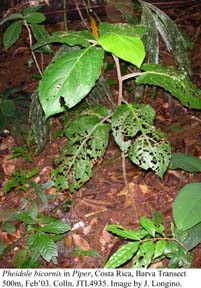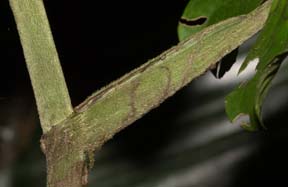Formicidae, Hymenoptera, Insecta, Arthropoda, Animalia
Atlantic lowlands |
Pacific lowlands |
Identification
Minor worker (La Selva): head length 0.54mm, head width 0.47mm, scape length 0.39mm, Webers length 0.67mm (n=1). Head somewhat flattened behind; promesonotum evenly arched, mesonotal suture absent; propodeal spines small but distinct; face smooth and shining, pronotum feebly punctatorugose dorsally, with large smooth and shiny patches on sides, mesonotum and propodeum foveolate; dorsal pilosity abundant, short, suberect, flexuous; color orange.
Major worker (La Selva): head length 1.04mm, head width 0.78mm, scape length 0.42mm (n=1). Anterior margins of frontal carinae in the form of distinct teeth, elevated and projecting from face; face entirely and coarsely punctatorugose, vermiculate rugae obliquely oriented in middle, irregular on sides, and transverse on vertex lobes; hypostomal margin nearly flat, with pair of sharp teeth located about one third distance from midline to recessed teeth flanking mandibles; dorsal pilosity abundant, short, somewhat lanose; sides of head with appressed to subdecumbent short pilosity, without conspicuous erect setae.
Variation: major workers from the Pacific side of Costa Rica have relatively wider heads (head length 1.06mm, head width 0.91mm, n=1), the hypostomal margin more concave, and the hypostomal teeth much smaller (n = 4 Pacific slope collections, 3 Atlantic slope collections).
Range
Panama (type locality Bugaba), Costa Rica (Atlantic and southern Pacific lowlands).
Natural History




Pheidole bicornis is the only Pheidole species known to be an obligate plant ant (although Pheidole minutula appears to be associated with a wide variety of ant plants in South America). It has developed a coevolved association with a group of Piper species in the wet forests of Costa Rica and adjacent portions of Panama and Nicaragua (Fischer et al. 2003; Letourneau 1983, 1990, 1991, 1998; Rickson and Risch 1984; Risch 1982; Risch et al. 1977). The pipers always contain nests of P. bicornis, and the ant species is never found nesting elsewhere. In Costa Rica the plants are common in wet forests of both Atlantic and Pacific slopes, to about 700m elevation.
There are three species of ant pipers in Costa Rica (Burger 1971). Piper cenocladum occurs between sea level and 1000m on the Atlantic slope. It is the common species at La Selva Biological Station. Piper fimbriulatum occurs between sea level and 1200m but is rarely collected below 500m. It is common on the southern Pacific slope between 600-1200m. Piper sagittifolium is endemic to the Pacific slopes of Costa Rica from the western part of the Valle General to the Osa Peninsula and the highlands near San Vito and Agua Buena.
The pipers are 1-2m tall plants that grow in the shaded understory of mature rainforest. The leaf petioles have expanded margins that are "clasping" such that they form an enclosed chamber in which the ants nest. At the base of the chambers the ants also bore into and hollow out the stem, such that the colony is distributed throughout multiple petiolar chambers and hollow stems of the plant. The plants produce small white food bodies on the inner walls of the petiolar chambers and these appear to be the main food source of the ants. Food body production is induced by the ants because plants grown in greenhouses without ants do not produce food bodies. Workers do not forage off their host plant, but they do forage at a low rate on the leaf surfaces.
Images of nests in Piper ant plants: click here.
A colony in Corcovado National Park contained 45 major workers, 70 minor workers, 7 adult males, 1 dealate queen, and brood. Most colonies appear to be monogynous, but one in Carara Biological Reserve (Bijagual) was polygynous.
The Pheidole-Piper association has been extensively investigated by Letourneau. She discovered that even though the ants are relatively passive and forage at a low rate, they still provide a net benefit to the plant by removing herbivore eggs and other small herbivores (Letourneau 1983). In subsequent studies she discovered a beetle in the family Cleridae that is a parasite of this mutualism, living in the petiolar chambers and feeding on ant larvae and plant food bodies (Letourneau 1990, 1991).
Fischer et al. (2003) studied nitrogen transfer from ants to plants, and their summary follows:
1 Nutrient fluxes play a significant role in the interaction of myrmecophytic plants and their symbiotic ants. There is a clear flux from plants to ants via nectar or food bodies but nutrient fluxes from ants to plants are less obvious.
2 We report on a nitrogen flux from ants to plants in the association between Pheidole bicornis (Formicidae-Myrmicinae) and two myrmecophytic Piper species (P. fimbriulatum and P. obliquum, Piperaceae). Pulse experiments were performed by feeding ants with 15N-labelled glycine supplied in sucrose solution. Workers passed ingested label on to other ants and the brood by trophallaxis.
3 The distribution of label within the colony showed highest incorporation rates in larvae and in the working caste, while the reproductive caste received only a small amount of the 15N-labelled food.
4 Nutrient transfer from ants to plants occurred remarkably fast. Within 6 days, up to 25% of the nitrogen ingested by the ants was incorporated by the plants.
5 However, ant distribution within P. fimbriulatum plants did not correlate with the intra-plant uptake pattern of 15N, and ant-mediated nitrogen uptake by myrmecophytic P. fimbriulatum accounted for less than 1% of the plants' above-ground nitrogen demand.
Literature Cited
Burger, W. 1971. Flora Costaricensis, Family #41, Piperaceae. Fieldiana, Botany 35:5-227.
Fischer, R. C., Wanek, W., Richter, A. and Mayer, V. 2003. Do ants feed plants? A 15N labelling study of nitrogen fluxes from ants to plants in the mutualism of Pheidole and Piper. Journal of Ecology 91:126-134.
Letourneau, D. K. 1983. Passive aggression: an alternative hypothesis for the Piper-Pheidole association. Oecologia 60:122-126.
Letourneau, D. K. 1990. Code of ant-plant mutualism broken by parasite. Science 248:215-217.
Letourneau, D. K. 1991. Parasitism of ant-plant mutualisms and the novel case of Piper. Pp. 390-396 in C. Huxley and D. Cutler, eds. Ant-Plant Interactions. Oxford University Press, Oxford.
Letourneau, D. K. 1998. Ants, stem-borers, and fungal pathogens: experimental tests of a fitness advantage in Piper ant-plants. Ecology 79:593-603.
Rickson, F. R., and S. J. Risch. 1984. Anatomical and ultrastructural aspects of the ant-food cell of Piper cenocladum C. DC. (Piperaceae). American Journal of Botany 71:1268-1274.
Risch, S. 1982. How Pheidole ants help Piper plants. Brenesia 19:545-548.
Risch, S., M. McClure, J. Vandermeer, and S. Waltz. 1977. Mutualism between three species of tropical Piper (Piperaceae) and their ant inhabitants. American Midland Naturalist 98:433-444.
Page authors:
John T. Longino, The Evergreen State College, Olympia WA 98505 USA. longinoj@evergreen.edu
Stefan Cover, Museum of Comparative Zoology, Harvard University, Cambridge MA 02138 USA. scover@oeb.harvard.edu
Date of this version: 2 September 2003.